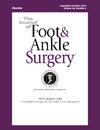Midterm functional outcomes of synthetic cartilage implant (SCI) arthroplasty for hallux rigidus
IF 1.3
4区 医学
Q2 Medicine
引用次数: 0
Abstract
Hallux rigidus is a common degenerative condition of first metatarso-phalangeal joint most commonly affecting patients above 50 years of age. The aim of our study is to evaluate the five-year results of synthetic cartilage implant (Cartiva) arthroplasty for hallux rigidus. A retrospective study of 70 patients who underwent synthetic cartilage implant interpositional arthroplasty were collected and analysed. Patients with Grade 3 to 4 hallux rigidus and who had failed conservative management were included. Patients who had previous forefoot surgery, hallux varus or valgus deformity of more than 250 and neuromuscular disease were excluded. Mean age at the time of operation was 63.4 years (range 42–84 years). The mean follow-up was 62.6 months. The functional evaluation was done using Manchester-Oxford Foot Questionnaire (MOxFQ). EQ-5D and EQVAS.
86 patients were matriculated in the study with 70 patients being assessed at five years. The average preoperative MOxFQ score improved from 35.74 (31.44-40.04) to 19.11 (11.31- 26.91) at one year after surgery. The EQ-5D scores improved from preoperative average of 9.40 (8.14-10.66) to 4.26 (2.09-6.43) at one year. The preoperative EQVAS was 61.66 (51.25-72.07) to 71.45 (60.87-82.03 at one year. At five years follow up the average MOxFQ score was 17.6 (9.92-24.38), EQ-5D - 4.8 (2.26- 6.45) and EQVAS – 72.48 (62.40-82.56). Three patients had revision to first MTP fusion due to ongoing pain.
Synthetic cartilage implant has demonstrated clinical efficacy and good functional outcomes at the end of five years for the treatment of Hallux rigidus.
合成软骨植入(SCI)关节置换术治疗硬下疳的中期功能效果。
拇指外翻是第一跖趾关节的一种常见退行性病变,50 岁以上的患者最为常见。我们的研究旨在评估合成软骨植入物(Cartiva)关节置换术治疗硬掌的五年效果。我们收集并分析了 70 名接受合成软骨植入物关节间置换术的患者的回顾性研究结果。研究对象包括保守治疗失败的3至4级Halux僵直症患者。既往接受过前足手术、拇指外翻或内翻畸形超过250以及患有神经肌肉疾病的患者被排除在外。手术时的平均年龄为63.4岁(42-84岁)。平均随访时间为 62.6 个月。功能评估采用曼彻斯特-牛津足部问卷(MOxFQ)、EQ-5D和EQV进行。EQ-5D和EQVAS。86 名患者参与了研究,其中 70 名患者在五年后接受了评估。术前的 MOxFQ 平均得分从 35.74(31.44-40.04)分提高到术后一年的 19.11(11.31-26.91)分。EQ-5D 评分从术前的平均 9.40(8.14-10.66)分提高到术后一年的 4.26(2.09-6.43)分。术前的 EQVAS 为 61.66(51.25-72.07)分,一年后为 71.45(60.87-82.03)分。五年随访时,平均 MOxFQ 得分为 17.6(9.92-24.38),EQ-5D 为 4.8(2.26-6.45),EQVAS 为 72.48(62.40-82.56)。三名患者因持续疼痛而对第一次 MTP 融合术进行了翻修。合成软骨植入物在治疗Hallux僵直症方面的临床疗效和五年后的良好功能效果已得到证实。临床证据等级:4.
本文章由计算机程序翻译,如有差异,请以英文原文为准。
求助全文
约1分钟内获得全文
求助全文
来源期刊

Journal of Foot & Ankle Surgery
ORTHOPEDICS-SURGERY
CiteScore
2.30
自引率
7.70%
发文量
234
审稿时长
29.8 weeks
期刊介绍:
The Journal of Foot & Ankle Surgery is the leading source for original, clinically-focused articles on the surgical and medical management of the foot and ankle. Each bi-monthly, peer-reviewed issue addresses relevant topics to the profession, such as: adult reconstruction of the forefoot; adult reconstruction of the hindfoot and ankle; diabetes; medicine/rheumatology; pediatrics; research; sports medicine; trauma; and tumors.
 求助内容:
求助内容: 应助结果提醒方式:
应助结果提醒方式:


